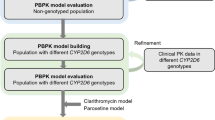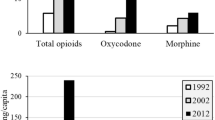Abstract
Chemotherapy-induced nausea and vomiting is one of the most concerning adverse drug effects from cytotoxic chemotherapy. Despite appropriate use of antiemetic guidelines, 20–30 % of patients experience breakthrough nausea and vomiting secondary to chemotherapy. To assess the variability of 5-hydroxytryptamine type 3 receptor antagonist efficacy caused by genetic variation, a review of the available literature was conducted. From the literature, three sources of pharmacogenomic variability were identified: polymorphisms associated with 5-hydroxytryptamine type 3 receptor subunits, drug metabolism via cytochromes P450, and drug transport in the body. Testing for receptor subunit polymorphisms is not applicable to a clinical setting at this time; however, cytochrome P450 2D6 testing is FDA-approved and widely accessible. Cytochrome P450 2D6 ultrarapid metabolizers and poor metabolizers displayed altered antiemetic efficacy when compared with intermediate metabolizers and extensive metabolizers. We postulate that testing for cytochrome P450 2D6 phenotypes may be the most accessible way to provide individualized antiemetic therapy in the future.

Similar content being viewed by others
References
Papers of particular interest, published recently, have been highlighted as: • Of importance •• Of major importance
Rojas C, Slusher BS. Pharmacological mechanisms of 5-HT(3) and tachykinin NK(1) receptor antagonism to prevent chemotherapy-induced nausea and vomiting. Eur J Pharmacol. 2012;684(1–3):1–7.
Blower PR. 5-HT3-receptor antagonists and the cytochrome P450 system: clinical implications. Cancer J. 2002;8(5):405–14.
• Feyer P, Jordan K. Update and new trends in antiemetic therapy: the continuing need for novel therapies. Ann Oncol. 2011;22(1):30–8. This is a review focusing on the mechanism of CINV and the problems associated with treatment.
•• Basch E, Prestrud AA, Hesketh PJ, et al. Antiemetics: American Society of Clinical Oncology clinical practice guideline update. J Clin Oncol. 2011;29(31):4189–98. These guidelines are widely used in patient care for the treatment and prevention of CINV.
•• Roila F, Herrstedt J, Aapro M, et al. Guideline update for MASCC and ESMO in the prevention of chemotherapy- and radiotherapy-induced nausea and vomiting: results of the Perugia Consensus Conference. Ann Oncol. 2010;21 Suppl 5:v232–43. These guidelines are widely used in patient care for the treatment and prevention of CINV.
•• National Comprehensive Cancer Network. Antiemesis. Available from http://www.nccn.org/professionals/physician_gls/pdf/antiemesis.pdf. Accessed Oct 2012. These guidelines are widely used in patient care for the treatment and prevention of CINV.
Gralla RJ, Roila F, Tonato M, Herrstedt J. MASCC/ESMO antiemetic guideline 2011. Available from http://www.mascc.org/assets/documents/MASCC_Guidelines_English_2011.pdf. Accessed Oct 2012.
Spiller R. Serotonin and GI clinical disorders. Neuropharmacology. 2008;55(6):1072–80.
de Wit R, Aapro M, Blower PR. Is there a pharmacological basis for differences in 5-HT3-receptor antagonist efficacy in refractory patients? Cancer Chemother Pharmacol. 2005;56(3):231–8.
Machu TK. Therapeutics of 5-HT3 receptor antagonists: current uses and future directions. Pharmacol Ther. 2011;130(3):338–47.
Thompson AJ, Lummis SC. The 5-HT3 receptor as a therapeutic target. Expert Opin Ther Targets. 2007;11(4):527–40.
Gregory RE, Ettinger DS. 5-HT3 receptor antagonists for the prevention of chemotherapy-induced nausea and vomiting. A comparison of their pharmacology and clinical efficacy. Drugs. 1998;55(2):173–89.
• Yaakob N, Malone DT, Exintaris B, Irving HR. Heterogeneity amongst 5-HT3 receptor subunits: is this significant? Curr Mol Med. 2011;11(1):57–68. This review provides a lot of background information about the structure, function, and variability of 5HT 3 receptor subunits.
Thompson AJ, Lummis SC. 5-HT3 receptors. Curr Pharm Des. 2006;12(28):3615–30.
Gandara DR, Roila F, Warr D, et al. Consensus proposal for 5HT3 antagonists in the prevention of acute emesis related to highly emetogenic chemotherapy. Dose, schedule, and route of administration. Support Care Cancer. 1998;6(3):237–43.
Tremblay PB, Kaiser R, Sezer O, et al. Variations in the 5-hydroxytryptamine type 3B receptor gene as predictors of the efficacy of antiemetic treatment in cancer patients. J Clin Oncol. 2003;21(11):2147–55.
Kaiser R, Tremblay PB, Sezer O, et al. Investigation of the association between 5-HT3A receptor gene polymorphisms and efficiency of antiemetic treatment with 5-HT3 receptor antagonists. Pharmacogenetics. 2004;14(5):271–8.
Fasching PA, Kollmannsberger B, Strissel PL, et al. Polymorphisms in the novel serotonin receptor subunit gene HTR3C show different risks for acute chemotherapy-induced vomiting after anthracycline chemotherapy. J Cancer Res Clin Oncol. 2008;134(10):1079–86.
Mujakovic S, ter Linde JJ, de Wit NJ, et al. Serotonin receptor 3A polymorphism c.-42C>T is associated with severe dyspepsia. BMC Med Genet. 2011;12:140.
Hoyer D, Hannon JP, Martin GR. Molecular, pharmacological and functional diversity of 5-HT receptors. Pharmacol Biochem Behav. 2002;71(4):533–54.
Krzywkowski K. Do polymorphisms in the human 5-HT3 genes contribute to pathological phenotypes? Biochem Soc Trans. 2006;34(Pt 5):872–6.
Krzywkowski K, Jensen AA, Connolly CN, Brauner-Osborne H. Naturally occurring variations in the human 5-HT3A gene profoundly impact 5-HT3 receptor function and expression. Pharmacogenet Genomics. 2007;17(4):255–66.
Brüss M, Barann M, Hayer-Zillgen M, et al. Modified 5-HT3A receptor function by co-expression of alternatively spliced human 5-HT3A receptor isoforms. Naunyn Schmiedebergs Arch Pharmacol. 2000;362(4–5):392–401.
Ward MB, Kotasek D, McKinnon RA. Investigation of HTR3C mutations for association with 5HT(3) receptor antagonist anti-emetic efficacy. Pharmacogenomics. 2008;9(8):1027–33.
Dubin AE, Huvar R, D'Andrea MR, et al. The pharmacological and functional characteristics of the serotonin 5-HT(3A) receptor are specifically modified by a 5-HT(3B) receptor subunit. J Biol Chem. 1999;274(43):30799–810.
Davies PA, Pistis M, Hanna MC, et al. The 5-HT3B subunit is a major determinant of serotonin-receptor function. Nature. 1999;397(6717):359–63.
Meineke C, Tzvetkov MV, Bokelmann K, et al. Functional characterization of a −100_-102delAAG deletion-insertion polymorphism in the promoter region of the HTR3B gene. Pharmacogenet Genomics. 2008;18(3):219–30.
Perwitasari DA, van der Straaten RJ, Mustofa M, et al. Differences in 5-hydroxytryptamine-3B haplotype frequencies between Asians and Caucasians. Int J Biol Markers. 2012;27(1):34–8.
Niesler B, Frank B, Kapeller J, Rappold GA. Cloning, physical mapping and expression analysis of the human 5-HT3 serotonin receptor-like genes HTR3C, HTR3D and HTR3E. Gene. 2003;310:101–11.
Niesler B, Walstab J, Combrink S, et al. Characterization of the novel human serotonin receptor subunits 5-HT3C,5-HT3D, and 5-HT3E. Mol Pharmacol. 2007;72(1):8–17.
Hammer C, Fasching PA, Loehberg CR, et al. Polymorphism in HTR3D shows different risks for acute chemotherapy-induced vomiting after anthracycline chemotherapy. Pharmacogenomics. 2010;11(7):943–50.
Guengerich FP. Cytochrome P450 and chemical toxicology. Chem Res Toxicol. 2008;21(1):70–83.
Bernard S, Neville KA, Nguyen AT, Flockhart DA. Interethnic differences in genetic polymorphisms of CYP2D6 in the U.S. population: clinical implications. Oncologist. 2006;11(2):126–35.
Ingelman-Sundberg M. Pharmacogenetics of cytochrome P450 and its applications in drug therapy: the past, present and future. Trends Pharmacol Sci. 2004;25(4):193–200.
Kaiser R, Sezer O, Papies A, et al. Patient-tailored antiemetic treatment with 5-hydroxytryptamine type 3 receptor antagonists according to cytochrome P-450 2D6 genotypes. J Clin Oncol. 2002;20(12):2805–11.
Davis MP, Homsi J. The importance of cytochrome P450 monooxygenase CYP2D6 in palliative medicine. Support Care Cancer. 2001;9(6):442–51.
Sachse C, Brockmöller J, Bauer S, Roots I. Cytochrome P450 2D6 variants in a caucasian population: Allele frequencies and phenotypic consequences. Am J Hum Genet. 1997;60(2):284–95.
Dilger K, Greiner B, Fromm MF, et al. Consequences of rifampicin treatment on propafenone disposition in extensive and poor metabolizers of CYP2D6. Pharmacogenetics. 1999;9(5):551–9.
Lam YW, Gaedigk A, Ereshefsky L, et al. CYP2D6 inhibition by selective serotonin reuptake inhibitors: Analysis of achievable steady-state plasma concentrations and the effect of ultrarapid metabolism at CYP2D6. Pharmacotherapy. 2002;22(8):1001–6.
Tzvetkov MV, Saadatmand AR, Bokelmann K, et al. Effects of OCT1 polymorphisms on the cellular uptake, plasma concentrations and efficacy of the 5-HT(3) antagonists tropisetron and ondansetron. Pharmacogenomics J. 2012;12(1):22–9.
Bloomer JC, Baldwin SJ, Smith GJ, et al. Characterisation of the cytochrome P450 enzymes involved in the in vitro metabolism of granisetron. Br J Clin Pharmacol. 1994;38(6):557–66.
Lamba JK, Lin YS, Schuetz EG, Thummel KE. Genetic contribution to variable human CYP3A-mediated metabolism. Adv Drug Deliv Rev. 2012;54(10):1271–94.
Hassan BA, Yusoff ZB. Genetic polymorphisms in the three malaysian races effect granisetron clinical antiemetic actions in breast cancer patients receiving chemotherapy. Asian Pac J Cancer Prev. 2011;12(1):185–91.
US Department of Commerce. An older and more diverse nation by midcentury. Available from http://www.census.gov.libproxy.lib.unc.edu/newsroom/releases/archives/population/cb08-123.html. 2008. Accessed Oct 2012.
Crews KR, Gaedigk A, Dunnenberger HM, et al. Clinical pharmacogenetics implementation consortium (CPIC) guidelines for codeine therapy in the context of cytochrome P450 2D6 (CYP2D6) genotype. Clin Pharmacol Ther. 2012;91(2):321–6.
Babaoglu MO, Bayar B, Aynacioglu AS, et al. Association of the ABCB1 3435C>T polymorphism with antiemetic efficacy of 5-hydroxytryptamine type 3 antagonists. Clin Pharmacol Ther. 2005;78(6):619–26.
Ishikawa T, Hirano H, Onishi Y, Sakurai A, Tarui S. Functional evaluation of ABCB1 (P-glycoprotein) polymorphisms: high-speed screening and structure-activity relationship analyses. Drug Metab Pharmacokinet. 2004;19(1):1–14.
Rivory LP. Optimizing the erythromycin breath test for use in cancer patients. Clin Cancer Res. 2000;6(9):3480–5.
Sanwald P, David M, Dow J. Characterization of the cytochrome P450 enzymes involved in the in vitro metabolism of dolasetron. Comparison with other indole-containing 5-HT3 antagonists. Drug Metab Dispos. 1996;24(5):602–9.
Fischer V, Vickers AE, Heitz F, et al. The polymorphic cytochrome P-4502D6 is involved in the metabolism of both 5-hydroxytryptamine antagonists, tropisetron and ondansetron. Drug Metab Dispos. 1994;22(2):269–74.
Siddiqui MA, Scott LJ. Palonosetron. Drugs. 2004;64(10):1125–32.
Astrellas Pharma. Nasea - detailed prescribing information. Available from http://www.mims.com/Thailand/drug/info/Nasea/?type=full. 2012. Accessed Oct 2012.
Firkusny L, Kroemer HK, Eichelbaum M. In vitro characterization of cytochrome P450 catalysed metabolism of the antiemetic tropisetron. Biochem Pharmacol. 1995;49(12):1777–84.
Dixon CM, Colthup PV, Serabjit-Singh CJ, et al. Multiple forms of cytochrome P450 are involved in the metabolism of ondansetron in humans. Drug Metab Dispos. 1995;23(11):1225–30.
Conflict of Interest
Morgan Trammel declares no conflict of interest.
Mary Roederer declares no conflict of interest.
Jai Patel declares no conflict of interest.
Howard McLeod declares no conflict of interest.
Author information
Authors and Affiliations
Corresponding author
Rights and permissions
About this article
Cite this article
Trammel, M., Roederer, M., Patel, J. et al. Does Pharmacogenomics Account for Variability in Control of Acute Chemotherapy-Induced Nausea and Vomiting with 5-Hydroxytryptamine Type 3 Receptor Antagonists?. Curr Oncol Rep 15, 276–285 (2013). https://doi.org/10.1007/s11912-013-0312-x
Published:
Issue Date:
DOI: https://doi.org/10.1007/s11912-013-0312-x




